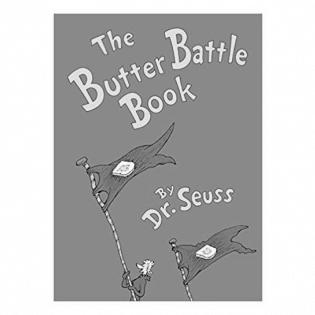The Butter Battle Book Literature Guide
This cautionary tale about conflict may be read on different levels for different ages. The factions formed over how to butter bread serve as a reminder that we can find common ground if we look for it. We can solve problems and respect differences in others. These are skills we need from childhood to adulthood. This book, through humor and exaggeration, serves as a springboard for a discussion on respecting differences in others. Everyone finishes this book understanding the absurdity of fierce fighting over something as silly as which way they buttered their bread. Although written during the time of the nuclear arms race, the message of peace is universal and timeless.
Before Reading
ASK: Would you like to eat your bread with the butter on the bottom? If not, would it bother you if someone else did it? Would you start a fight with someone who did it?
SHOW: Look at the picture of the wall with the poster on it that says, “Yooks are not Zooks. Keep your butter side up!” This wall was built to separate people who butter their bread differently.
CONNECT: People are different in many ways, but they are also the same in many ways. Have you ever thought someone was strange because he or she was different? Is it okay for people to be VERY different from you? Think of someone in your community or school that you think is “weird.” Is it possible that this person is simply different and that difference may make him or her interesting? Talk about what might happen if you tried to get to know this person.
During Reading
ASK: Why do the Yooks and Zooks keep getting bigger and stronger weapons?
SHOW: Look at the picture with the “butter-up band.” Talk about what the cheerleaders of the Zooks might say or do on their side of the wall.
CONNECT: In disagreements that you know of, have you ever seen someone change their arguments or weapons to seem stronger? What happened then?
After Reading
ASK: Can anyone win this battle? How or why not?
CONNECT: Think about a conflict that you have been involved in (or have read about). How might you resolve the conflict sooner? Is it possible to have a fight in which both sides win? How can you get into a “win-win situation?”
Activities
- For older children, relate this story to the wars and conflicts in the world today or in our history. Compare and contrast the events in this story with the events in the real situations.
- Think of an ongoing conflict in your home, such as keeping your room clean, sharing a toy or game, or whose turn it is to walk the dog. Try to see the conflict from the perspective of Dr. Seuss. Think of clever slogans for your side of the argument, design a banner for your argument, and think of the extreme result of getting your way or not getting your way. Then after having fun with the idea, get together with all the people involved and talk about both sides of the issue. Try to solve the conflict in a way that seems fair to everyone.
- Dr. Seuss designs some very clever contraptions with very descriptive names. On paper, design your own clever contraption that will do a job around your house or perform any other task. Draw the contraption, give it a name and write about what it does.
- Think about a person or group of people in your school or community who is/are “different” from you in some way. Talk about how you can make a connection with that person or group. This may include making a new friend, helping at a soup kitchen, or helping with a project. Talk about the best way to approach the person in an open and friendly way. Discuss what it means to show respect others.
- Sometimes problems arise because of misunderstandings. Think of caring statements you can make to stop a conflict before it grows. Make a list of statements, such as “I’m sorry” or "Can you help me understand?"
